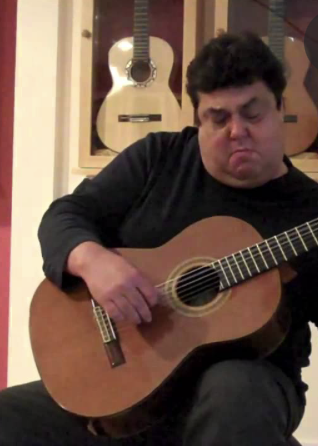|
Other
SONIC JUXTAPOSITION AT MENDO FESTIVAL'S ORCHESTRAL CONCERT
by Terry McNeill
Wednesday, July 24, 2024
Other
CHARMING "BARBER" A MENDO FESTIVAL TRIUMPH
by Pamela Hicks Gailey
Friday, July 21, 2023
Other
JOYFULLY WE SING
by Pamela Hicks Gailey
Thursday, February 23, 2023
Other
SUBDUED PIANISM IN RARE FORTEPIANO RECITAL IN THE RAVEN
by Terry McNeill
Sunday, February 12, 2023
Other
DINOVA PIANISM CHARMS SATED AUDIENCE AT J-B MARIN RECITAL
by Terry McNeill
Sunday, November 20, 2022
Other
CLEARY'S NEW ORLEANS BAND IGNITES PARTY FOR THE GREEN AT SSU
by Terry McNeill
Saturday, September 25, 2021
Other
SIX GUITARISTS IN UNIQUE NAPA RECITAL
by Gary Digman
Sunday, July 25, 2021
Other
STUNNING LINCOLN CENTER CONCERT LAUNCHES FIFTH WEILL SEASON
by Philip Beard
Saturday, October 1, 2016
Other
LATE BEETHOVEN EXPLORED AT MMF CONCERT IN PRESTON HALL
by Paula Mulligan
Thursday, July 21, 2016
Other
ANGUISH AND TRIUMPH IN MENDOCINO FESTIVAL'S BIG TENT
by Kayleen Asbo
Sunday, July 10, 2016
|
 |
 Guitarist Eric Symons |
SIX GUITARISTS IN UNIQUE NAPA RECITAL
by Gary Digman
Sunday, July 25, 2021
The first Napa Valley Guitar Festival was held at Napa’s First Presbyterian Church July 25, and featured performances from six classical guitarists. The Church is an iconic structure in downtown Napa, its huge white presence dominating the scene, and the white theme continues inside punctuated by beautiful stained glass. The acoustics are surprisingly good and guitar friendly. The concert consisted of four short solo sets, one from each of four of the guitarists, a duet set, and an encore featuring all six of the guitarists.
George Benton England, Napa Valley College guitar professor, began the concert playing a 19th century instrument that has a much smaller body than the modern classical guitar. Mr. England played standing, which is an unusual playing position for classical guitar. He began his set with a transcription of three pieces from “Suite in D Minor for Theorbo” by Charles Hurel, from about 1680. The theorbo is a large member of the lute family with 13 or 14 strings which has a deep resonant sonority because of its size and many bass strings. I felt that something was lost in transferring the pieces to the small 19th century guitar.
Mr. England finished his set with Sor’s “Introduction and Variations on the theme Duke of Marlborough.” The performance of the piece was thoughtful, well played and appropriate for the 19th century guitar as Sor himself played a similar guitar when he lived in Barcelona, Paris, St. Petersburg and London.
The second set featured Florante Aguilar playing a collection of original compositions and popular Philippine songs. Mr. Aguilar’s compositions were engaging and inventive, largely chordal textures employing arpeggios and rasqueado techniques. The artist displayed a mature technique and competent mastery of the classical guitar.
There was an intermission during which gratis refreshments were served in the antechamber.
Following intermission Matthew Grasso took the stage for a third set, and he was listed in the program as composer and arranger as well as a performer. The set opened with an original composition entitled “Chomolungma,” the Tibetan name for Mt. Everest in the Himalayas. “Chomolungma” consisted of three movements each moving higher in pitch to suggest the ascent and descent of the mountain. Mr. Grasso closed with classical guitar arrangements of two jazz standards, “My Funny Valentine” and “My Favorite Things.” “My Favorite Things” included some polyrhythmic (3 against 2) passages. The jazz standards left me wanting more as they only consisted of arrangements of the melody without much thematic development.
Marc Teicholz was the fourth guitarist and began with his arrangement of Debussy’s “Claire de Lune”. “Claire de Lune” is a particular challenge to arrange for classical guitar, and Mr. Teicholz met the challenge with his masterful arrangement and virtuosic playing. He then played four short pieces by Sergio Assad entitled “Portrait of Antonio Lauro,” Lauro being the famous Venezuelan guitar virtuoso and composer, dying in 1986. Mr. Teicholz’s playing disclosed a seasoned and mature recitalist whose interpretation had authority and instrumental polish.
The final set featured the duo of Eric Symons and Pat Imbimbo, and opened with Laurindo Almeida’s transcription of the Albeníz Tango in D Minor, Op. 165, No. 2. Mr. Symons introduced the work by saying his first hearing of it was what inspired him to take up classical guitar, and the piece has had many transcriptions including for violin and (by Godowsky) piano. The duo continued with an arrangement for two guitars of Albeniz’ Granada, which is usually played as a guitar solo. The final offering was Giuliani’s arrangement of the Overture to the Opera “Barber of Seville” by Rossini. The last was the most successful performance and a concert highlight. Mr. Symon's attack was often aggressive and somewhat inconsistent, contrasting with Mr. Imbimbo’s more delicate touch and greater control of the demanding music.
There was an encore: all six playing the Allegro from Vivaldi’s Lute Concerto in D, RV93, written in the 1730s. I found the performance needed more rehearsal and sonic balance, but it was an encore and perhaps was a first local reading of the complicated work, the transcriber unnamed.
This unique concert was organized by Napa Valley Music Associates Director Marcia Battat, who is hoping to make it an annual event.
|

